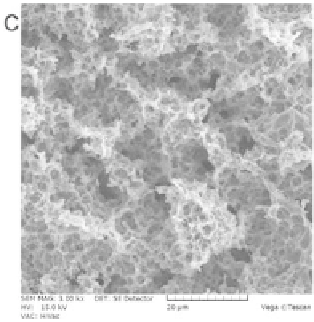Biomedical Engineering Reference
In-Depth Information
samples, phosphorus is observed (incorporated to the oxide layer
from the H
3
PO
4
electrolyte). Phosphorus, together with calcium
(from the glass) is attractive for osseointegration. It is signiicant
that longer etching time results in decreasing oxygen content from
4.36 to 1.83 wt% for 15 and 60 min etching time, respectively. This
means that longer etching results not only in porous oxide formation
but also in oxide dissolution. So, after initial fast oxidation, the TiO
x
etching rate, exceed TiO
x
formation, or in the electrolytes containing
HF the oxides are preferentially etched.
The HF is used to enhance etching and the current density is
signiicantly greater, than for electrolyte without HF. The HF content
in the electrolyte results in trace of luorine, detected on sample
etched for 30 min.
Figure 9.60
SEM images of the Ti-glass nanocomposites after etching in
1M H
3
PO
4
+ 2% HF at 10 V for 15 (a), 30 (b) and 60 (c) min
[31].


















